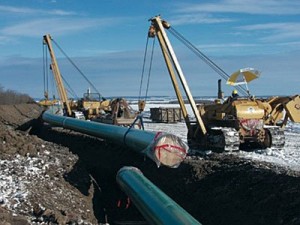Keystone Still Faces Delays, Fierce Opposition From Green Groups
 The Keystone XL pipeline cleared another major hurdle last week, but that doesn’t necessarily mean smooth sailing for the beleaguered project, at least not if the pipeline’s fiercest critics have their way.
The Keystone XL pipeline cleared another major hurdle last week, but that doesn’t necessarily mean smooth sailing for the beleaguered project, at least not if the pipeline’s fiercest critics have their way.The opposition is already mobilizing in the wake of the draft environmental review released by the State Department last week, which found that the northern leg of TransCanada’s Keystone XL pipeline—designed to transport crude oil from Alberta to Gulf Coast refineries—would not significantly add to global greenhouse gas emissions.
Opponents of the pipeline argue that construction of Keystone will result in the massive expansion of oil sands production, one of the most energy and carbon-intensive resources to extract. But according to the State Department’s findings, regardless of whether the 800,000 barrel-per-day pipeline is built Canadian oil sands product will make it to market, if not by pipeline then by some other method such as rail.
But that argument doesn’t hold water for some environmental groups.
“It’s sort of like saying ‘We’re not going to look at the environmental impacts of building a shopping center here, because somebody might build something there later,’” says Susan Casey-Lefkowitz, director of the International Program at the Natural Resources Defense Council.
According to the NRDC, the State Department’s report overlooks what they argue is an explicit connection between building the pipeline and the expansion of oil sands production. Currently without the pipeline, production has abated thanks to a glut of supply in the Midwest, where most of the Canadian oil sands product travels to. But if the pipeline is built, that glut will be relieved giving producers incentive to expand operations, a move the NRDC says would have dire consequences on the environment.
Others argue it will have a negative impact on American consumers as well. Although sometimes billed as a key piece in America’s booming domestic energy industry, some critics say the real beneficiaries are oil companies who will use the pipeline to transport crude through the U.S. to export to foreign markets where prices are higher. That in turn could push domestic gas prices higher if oil prices climb as supply is gobbled up abroad.
“The State Department needs to explain how it is in America’s national and economic interests to facilitate Keystone XL’s completion, especially if the pipeline is simply a conduit for oil and refined products to go elsewhere that makes the United States less energy secure and drives domestic gas prices higher,” Senate Energy and Natural Resources Committee Chairman Ron Wyden of Oregon said in a statement.
Environmental groups opposing the pipeline have another ally on their side: time.
The environmental impact report released by the State Department is only a draft version, and the public now has 45 days to submit comments on the findings, after which the agency has 90 days to determine whether the project is in the nation’s best interest.
Opposition groups have already complained about the length of the comment period, arguing that 45 days isn’t nearly long enough for affected groups to sift through the 2000-page document.
“We’re asking the State Department to make it longer,” Casey-Lefkowitz says. “For landowners along the pipeline route to be able to review this document in between their busy work day, it’s only fair to give them a longer period of time than just a little over a month.”
The State Department could extend the comment period, further delaying the approval process, a measure it has taken before regarding previous environmental impact studies. And further delays are exactly what some opposition groups want in hopes that TransCanada might ultimately give up the more than four-year-long fight to construct the Keystone pipeline.
“If Keystone XL doesn’t happen or gets delayed a full year plus, you’re talking about projects having to be put on the shelf,” Phil Skolnick, an analyst at Canaccord Genuity Corp., told Bloomberg News.
After the public comment period ends, the State Department will do a final environmental review and proceed to the national interest review, necessary in the case of Keystone’s northern leg because it crosses an international border. Opposition groups could still file legal complaints ahead of the national interest review to delay proceedings further.
You can return to the main Market News page, or press the Back button on your browser.

